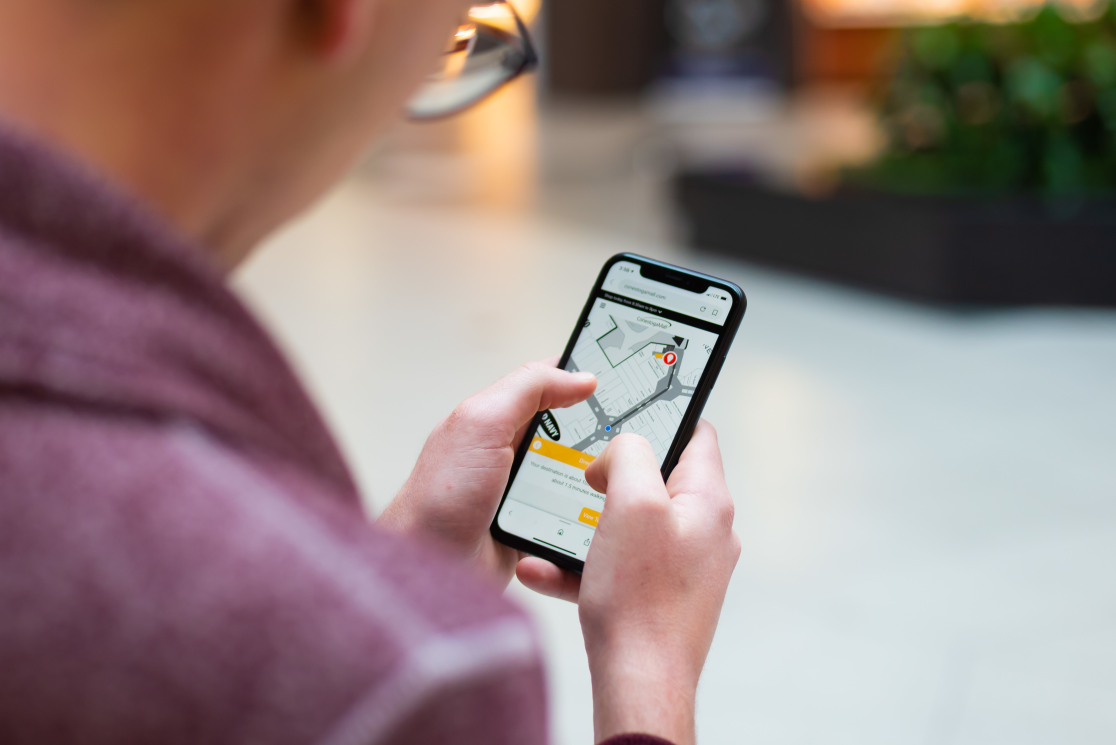Return to Resources
Blue Dot Navigation For Airports
Mar 24, 2022
7 min read
Planning your next flight? Find out how airports can use digital maps with blue dot navigation to provide the best travel experience.

What is Blue Dot Navigation?
With indoor positioning, users can see their precise location represented by a blue dot within the context of an indoor map. Similar to outdoor GPS, users are not required to enter a "start" destination and as they begin to follow along a route, the blue dot moves with them, providing an enhanced navigational experience. This is also known as blue dot navigation.
Indoor Positioning System (IPS)
An indoor positioning system (IPS) can be thought of as GPS for indoor venues. Using a variety of methods, these systems can detect real-time locations to determine the coordinates of people or assets inside a building. These coordinates are typically represented visually by a blue dot on a digital indoor map to provide wayfinding and additional context to users.

The Future of Aviation with Indoor Wayfinding
With indoor positioning and wayfinding, passengers can receive a personalized journey with turn-by-turn directions from the moment they park their car to the second they arrive at their gate. Instead of rushing to catch a flight, this technology guides passengers through crowded airports in the most efficient way possible, ensuring a seamless and stress-free travel experience.
Why Use Blue Dot Navigation for Airports?
While booking a flight is fun and exciting, navigating through an airport is not. Locating busy terminals and departure gates can be stressful, especially when timing is of the utmost importance. With blue dot technology, airports can make navigation simple by providing helpful directions and additional context to travellers. Integrated with proximity messaging, airports can also send alerts to passengers of delays or interruptions along their route.
Find Your Ride
Finding your way around an airport doesn’t have to be confusing. Digital mapping and navigation technology helps you promptly locate your boarding gate, terminal, baggage claim, and the closest ticket counter. You can also navigate the shortest route between multiple stops and determine how long it will take to reach important airport checkpoints, enabling you to plan your trip ahead of time.

Stay Up-to-Date
With digital mapping technology, airports can provide passengers with up-to-date travel information regarding flight delays and cancellations, gate changes, weather conditions, and more. For instance, personalized messages can inform passengers that they’re scheduled to board the plane in half an hour. This information can also be accessed with digital directories throughout the airport, or on QR codes placed on plane tickets. With real-time travel information available at your fingertips, keeping track of flight changes is simple.
Gain Insights
A navigation system also provides airports with valuable insights and analytics. Airports can better understand how travellers move through the space, analyze search data to determine the most popular destinations, view top category selections, device usage, and more. These insights can be used to redesign the airport layout to avoid overcrowding, optimize passenger flow, and ensure the most popular amenities are placed in the most optimal locations. Missed searches can also indicate areas of potential investment that would drive increased revenue.

Seamless Outdoor-Indoor Wayfinding
With an indoor mapping platform on-hand, travellers can enjoy seamless indoor outdoor navigation at airports. Simply locate the closest parking to your terminal, populate the fastest route to the airport entrance, and follow step-by-step directions to your boarding gate. This navigational tool also ensures a seamless connection from the airport to your hotel through shuttle services, delivering an enhanced passenger experience.
Real-Time Facilities Management
With Mappedin’s platform, facilities teams can edit maps in real-time, meaning visitors can rely on accurate directions and information at all times. From long-term venue changes, to small or temporary changes, airports can ensure that maps are consistently up-to-date. For instance, if a particular area is closed, you can mark this as off-limits on your map and redirect visitors through a different route. You can make quick changes to labels on the map, rearrange rooms and amenities, customize branding, and much more. These tools make maintaining, updating, and growing your maps a simple task.
A Variety of Solutions to Fit Your Journey
Passengers can access digital maps from a variety of touchpoints including web, mobile, and digital directory displays. Airports can implement this navigation technology into their existing mobile apps, on their website, or on printed materials through QR codes for directions and updates on-the-go. With digital directories in key locations, such as boarding gates, passengers can get flight updates while they wait to board the plane. With a wide array of digital mapping solutions, airports can enhance the travel experience from all angles.

Transportation Reimagined
Airports can provide seamless navigation for thousands of passengers on a daily basis with an integrated transportation hub. With Accessibility Mode turned on, individuals with accessibility needs, such as families with strollers and individuals bound to wheelchairs, can populate routes that prioritize ramps and elevators over stairs. Indoor navigation systems can also operate with voice commands or written instructions to ensure that maps are attainable and accessible to all.
Create a Smart Travel Environment
Airports can create a smart travel environment by combining accurate positioning and blue dot wayfinding with a digital map. Along with providing the fastest route, indoor mapping technology can integrate with ads, promotions, and proximity messaging to highlight retail offerings. Indoor positioning technology can notify passengers of a sale at a nearby retail space or simply highlight a key destination for travellers such as security check-in or baggage claim. Moreover, airports can improve operational efficiency through data-driven space planning and asset tracking.
What Sets Mappedin Apart?
With Mappedin’s indoor mapping platform, convert 2D blueprints of your airport into digital, intuitive, 3D transit maps. Using our simplified Map Creator and Editor, make edits to your map in real-time and distribute the latest changes and property details across multiple platforms including web, mobile, and directory kiosks. Mappedin's permission levels allow facilities teams to collaborate in one centralized tool, simplifying your workflow and map management.

Blue Dot Navigation For Airports Frequently Asked Questions
Do You Need an Internet Connection While Navigating?
No. Once the map has been loaded, you do not need an internet connection for blue dot wayfinding. The blue dot experience does require indoor positioning, but will function without an internet connection. For blue dot using Apple devices, wi-fi should be on but does not need to be connected to the venue wi-fi. This way, positioning systems can see access points and the blue dot experience will work in its more accurate form.
What Is An Indoor Positioning System Without Beacons?
Infrastructure-free systems do not require beacon technology, and rely solely on a user's mobile device and the WiFi within a venue. Apple’s indoor positioning is an example of this as it uses your existing WiFi to achieve GPS-level accuracy in indoor spaces by using the radio frequency (RF) patterns of your WiFi access points. Infrastructure-free in this case is a cost effective solution. Positioning systems that utilize hardware such as beacons can be implemented to supplement infrastructure-free solutions but can come with a large price tag both to set up and maintain over time.
What Other Technologies Can Be Integrated With Indoor Navigation Systems?
There are several integrations that can be layered onto an indoor map. Indoor positioning technology can be used to pinpoint a user's precise location and enable other experiences such as location sharing and proximity marketing. Augmented Reality (AR) can be layered on top of the digital indoor map to provide another level of context for users and to further enhance the travel experience. Users can simply hold their device within the venue and see virtual elements that deliver relevant information.
Learn more about transportation hub mapping software on our website, visit our Airports industry page, or contact us for a free airport wayfinding demo.


